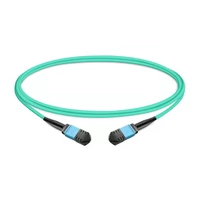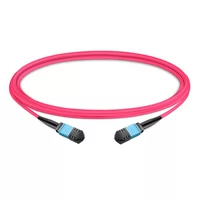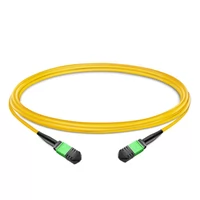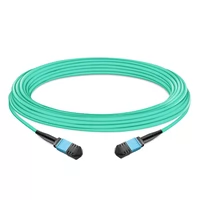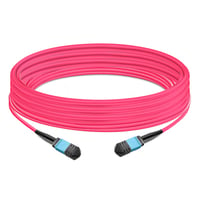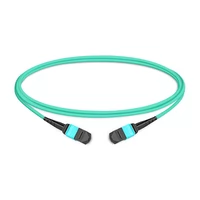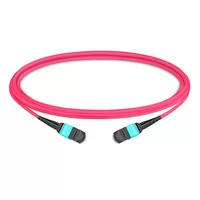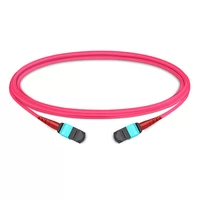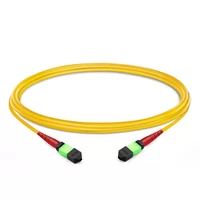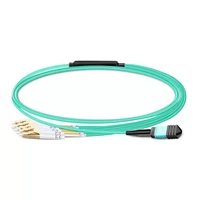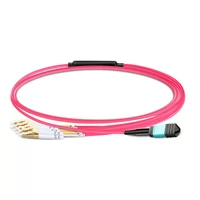Understanding the Basics
MTP® (Mechanical Transfer Pull Off) and MPO (Multi-Fiber Push On) connectors are key components of fiber optic communication systems that ensure fast data transfer across networks. Although both connectors are used in high-density applications, their performance characteristics often determine when each should be applied.
Key Differences
Design and Structure
Designed as an improved version of the generic MPO connector, MTP® boasts extra features to ensure better performance and reliability than its predecessor. Among these features is a floating ferrule design with metal pin clamps, which enhances mechanical stability and improves fiber alignment. Conversely, standard MPO connectors have simpler constructions that can lead to less accurate alignments and higher insertion losses.
Performance
The main difference between these two types lies in how much they can deliver in terms of performance where it counts the most – connectivity. Compared to common or garden variety MP0, this usually means lower IL (Insertion Loss) and higher RL (Return Loss). This is because MTPs are manufactured with very tight tolerances, which result in good physical connection between fibers, thus reducing chances for errors during data transmission.
Scalability and Flexibility
Scalability was part and parcel when creating any product but even more so within the telecoms market, where bandwidth demands keep growing year after year without any signs of stopping soon; this being said, scalability should never be overlooked, especially when deploying cabling systems such as those using either one among many others available solutions like multi-fiber push-on connectors like mtp. One connector capable of accommodating up to seventy-two fibers only while taking the same amount of space occupied by a few other different connectors provides an easy way to meet the needs of high-density environments including but not limited to computer rooms, Cable TV centers, data storage facilities, etcetera….
Cost Considerations
If you want something good, buy cheap twice; otherwise, invest once in quality products like mtp; efficiency, reliability always, and parts due to advanced features incorporated during the manufacturing process, thus making them outperform mp0s in the same field over time, reducing maintenance costs while enhancing network reliability. This justifies expenditure on mtps where necessary although there can be situations with tight budgets whereby you need reliable connections; hence, opt for less costly but still efficient solutions such as multi-fiber push-on(MPO) connectors.
Conclusion
The choice between these two types mainly depends on your network’s performance, scalability, and budget needs. MTPs offer excellent performance and flexibility, whereas MPO connectors provide cost-effective options for less demanding applications. Knowing all these facts should help you make better decisions that will result in efficient and reliable fiber optic networks.
Table of Contents
ToggleWhat is an MPO Connector?
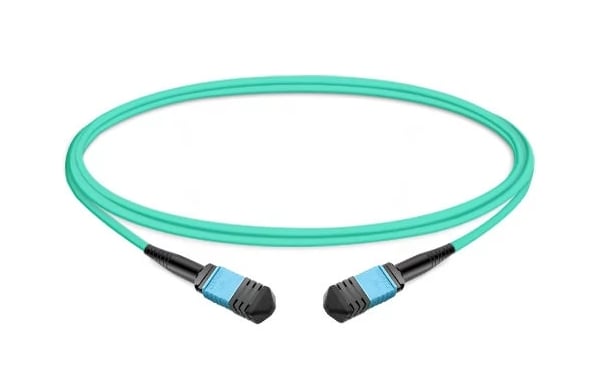
Understanding MPO Connector Basics
MPO connectors were established as high-density, standardized fiber optic connectors to facilitate numerous fiber cables within a single unit. Usually, these connectors have 12 or 24 fibers but can handle even 72 or more fibers, which makes them perfect for applications that require huge bandwidths. Because they are small in size, MPO connectors save a lot of space in data centers, computer rooms, and any other place where there is a need for dense cabling with optical fibers. One thing about them is that they are very easy to install and maintain, thus making it simpler for people to set up networks while at the same time ensuring reliable performance.
Applications of MPO Connectors in Data Centers
MPOs are vital to current data center infrastructure since they can support high-density fiber connections effectively. Below are some examples:
- High-Density Interconnects: MPO connectors help create high-density interconnects, which are necessary for space-saving and better performance utilization. They can accommodate up to 72 fibers within a single connector and hence can be used in areas where space is limited.
- Scalability: MPO connectors offer the required flexibility as data centers grow with demand. They allow for easy upgrades from 10G to 40G or 100G networks without having to make major changes, ensuring the system’s scalability.
- Simplified Cable Management: MPOs enhance cable management by reducing the clutter that may hinder airflow. This organization improves cooling, leading to reduced heat-related failures.
- Quick Deployment and Maintenance: MPO connectors can be deployed rapidly due to their plug-and-play nature, minimizing downtime during installations. Maintenance is also made easier, especially in environments demanding continuous operation time.
- Performance Metrics: These are some key technical parameters used in designing an MPO connector;
- Insertion Loss: Usually less than or equal to 0.35dB for standard connectors.
- Return Loss: Greater than 20dB, ensuring signal integrity is maintained throughout transmission line length.
- Durability: Rated beyond 500 mating cycles thus highly durable even under heavy use conditions such as those found in busy offices or industrial settings where frequent plugging/unplugging activities occur.
- Compliance: Designed according to IEC and TIA standards, thereby ensuring compatibility between different brands/models so that users can mix components from various vendors within the same network segment without experiencing any connectivity issues whatsoever.
- These applications, along with technical metrics, highlight how important MPO connectors are in enabling efficient, scalable, and high-performance data centers.
MPO Connector Variants: Single-mode and Multimode
There are two main types of MPO connectors: single-mode and multimode. These different kinds serve various communication needs and have different technical specifications.
Single-mode MPO Connectors
Single-mode MPO connectors are intended for long-distance data transmission; they use a smaller core size of around 8-10 microns for the light to propagate accurately. This reduction eliminates modal dispersion, thereby enabling high bandwidths over long distances that can exceed 10 km at times. Single-mode connectors usually have lower insertion loss, important for signal stability across larger spans. They are primarily used in telecommunications or any other environment, and there is a strong need for wide-area networks.
Multimode MPO Connectors
Meanwhile, multimode MPO connectors are designed for shorter distances – typically up to 500 meters -hence making them best suited for enterprise networks and data centers. They have a larger core size (usually about 50 – 62.5 um), which allows more than one path of light through the core, resulting in higher data rates within its short ranges. Multimode connectors fall under OM3, OM4, or OM5 categories, with each grade having different performance levels, but generally speaking, OM4 & OM5 support higher speed transmissions over longer distances than OM3.
To correctly choose an appropriate solution based on specific networking requirements, one must be able to differentiate between these two types in terms of physical properties and where they apply most effectively.
What is an MTP® Connector?
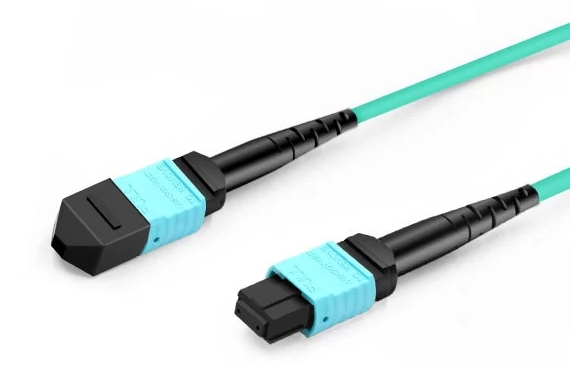
Key Features of MTP® Connectors
MTP® connectors are a product of US Conec registered under trademark, which has various features that were developed to optimize high-density fiber optic networks. What distinguishes them is their ability to connect many fibers concurrently without compromising mechanical and optical performance, unlike other MPO connectors. Here are some of the main points
- Better Optical Performance: With low insertion loss and high return loss capability, MTP® connectors ensure reliable signal integrity while supporting applications with greater bandwidth.
- Increased Precision and Alignment: Accurate alignment among fibers is crucial for high-density systems operating at high data rates; this is achieved through the employment of MT ferrules, which can be molded precisely within these types of connectors. In addition, they possess a floating ferrule design that enables physical contact, keeping in mind different environments.
- Scalability: The ability to configure from 8 up to 72 strands helps in scaling networks easily and changing them frequently where necessary, hence making them suitable for easy upgrades or reconfigurations.
- Long Life Span: They were designed with external robustness and recessed pin features meant to protect cables during mating/ demating, thus reducing the chances of breakage.
- Easy To Install—These connectors offer better connectivity options because they use push-pull latching mechanisms, which make it easier even when dealing with dense network settings. All one needs to do is pull outwards instead of first finding small bullets before removing them, unlike other methods used today, where people have to find little bullets before removing them.
- Customizable Outlook -They come in different shapes, mainly male/female, and are available across multiple polarities depending on various networking needs.
In conclusion, MTP® connectors are best suited for efficient high-speed connections required by telecommunication networks, among others, such as those found in data centers characterized by their excellent performance levels.
MTP® Connectors vs Generic MPO Connectors
Some differences between MTP® connectors and generic MPO connectors need to be considered regarding their influence on performance, reliability, and usability in high-density fiber optic networks:
- Performance: One-way MTP® connectors differentiate themselves from generic MPO connectors is that they are made according to stricter tolerances, thereby providing better optical performance. Lower insertion and higher return losses improve signal integrity and overall network performance.
- Precision and Design: The ferrule alignment mechanism on an MTP® connector is more precise than those found on standard MPO connectors. This unique floating ferrule design helps keep physical contact between fibers even when conditions change, thus decreasing the chances of optical signal loss compared with normal MP0s.
- Customization & Flexibility: Unlike ordinary MP0s, which offer limited customization options, MTPs come with different fiber counts (8-72 fibers), polarity configurations, and male/female versions, among other things. This allows superior scalability during the network planning stage and overall better design, while generic types may lack these features altogether.
- Durability: Compared to typical MO connections, where pins stick out of easily breakable parts without any external housing protection whatsoever, MTPTMs have been designed to incorporate some ruggedness so that they can withstand frequent mating and De-mating operations without easily getting damaged.
- Ease of Use: For easy installation or removal, especially under dense installations where numerous connections have been crammed within small spaces, thereby making it difficult for one person alone without tools like plyers, etc., to do much pulling or pushing around multiple cable ends.
This summary tells us that although both serve similar functions towards enabling fast networking, speed networking takes place over short distances while still being able to handle huge amounts of data capacity centers located far away from each other throughout many cities across the globe region-wide area networks or WANs
How MTP® and MPO Connectors Differ in Performance
When you compare MTP® connectors with MPO connectors, you will notice several differences between them. These differences revolve around insertion loss, return loss, and general reliability:
- Insertion Loss: In most cases, generic MPO connectors have higher insertion losses than MTP® connectors. This happens because they use more precise manufacturing tolerances during production and employ superior-quality materials that facilitate good fiber alignment and contact. The low rate of signal degradation over the network can be attributed to decreased levels of insertional loss.
- Return Loss: They also provide better performance concerning return loss capability. More refined designs within these terminals decrease the light reflected toward its source, thereby maintaining higher signal integrity while suppressing potential interference.
- Reliability: Moreover, advanced engineering incorporated in them ensures increased reliability, especially under harsh conditions where other types may fail frequently. This is achieved through a more robust physical build with unique features like better spring systems or even ultrasonic weldings, making them less prone to connection failures and having longer operational life spans than ordinary MPO connectors.
To sum up, when it comes to insertion loss, return loss, and reliability measurements, MTP®s outperform all other categories, hence making them ideal for high-performance networks that require consistent fast data transfer rates.
How Do MPO and MTP® Cables Differ?
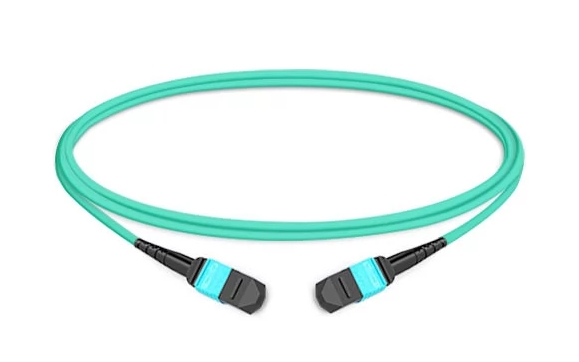
MPO Cable Structure
Multi-Fiber Push-On cables, or MPO cables, are designed for high-density fiber optic connectivity. The typical design of an MPO cable has many fibers, with 8, 12, or 24 fibers per connector being the most common configurations. These are surrounded by a protective outer jacket made from strong and flexible optical fibers.
Parts:
- The MPO Connector is a multi-fiber array connector standardized by IEC 61754-7 and TIA/EIA 604-5. It uses a push-pull mechanism that aids in fast connection and disconnection. Guide pins in the connector ensure precise alignment between pairs of fibers.
- Ferrule: A ferrule can hold several optical fibers in line in the MPO connector system. Its key function is to ensure stable alignment with minimum insertion loss.
- Housing: The housing excels at providing support and protection for connectors and sliding during push-pull operation. It needs to be engineered with precision so that it has low return loss but high reliability.
- Boot: This reinforces strain relief on cables at their rear ends, where they meet up with other devices such as connectors, thus preventing bending, which would have otherwise shortened the life span of such cables.
MPO cables play a critical role in contemporary data centers and telecommunication networks that require large data transfer rates coupled with scalability in architecture. Such cables are capable of accommodating bulky fiber counts within limited spaces, making them ideal for applications where space needs to be efficiently utilized while still achieving high speeds during information transmission.
MTP® Cable Construction
MTP® cables are like MPO cables in most ways but have higher manufacturing tolerances and are made with more precise engineering, offering better mechanical reliability and performance. Created for use in data centers and enterprise networks that demand high-bandwidth data transmission capabilities, the MTP® connector is an improvement on the design of its predecessor; it can also be said that this product was made specifically to meet such needs.
Parts:
- Ferrules with High Performance: These types of connectors typically have elliptical guide pins as well as tightly aligned ferrules, which reduce fiber misalignment, thus reducing signal loss caused by insertion or return loss while improving the integrity of signals at each endpoint where they are connected within any given system.
- Housing That Can Be Taken Off: What sets apart one kind from another lies in how easy it is to polish again after being used once. Some designs allow for re-polishing or even reworking, which makes maintenance flexible enough since different parts may require upgrades over time.
- Floating Ferrule Design: The floating ferrule helps maintain physical contact with slight mechanical disturbances, ensuring consistent performance and reliable connections during cable handling and installation.
- Metal Pin Tips And Anti-Snag Latch: While the inclusion of metal pin tips leads to greater durability through their increased lifespan usage when accidentally disconnected from an anti-snag latch won’t cause any damage at all due its design preventing such occurrences.
MTP® cables are critical in high-density situations because they support multi-fiber interface technology and parallel optics, which enable quick network growth through efficient data transfer. Their robust build quality, coupled with superior optical performance, has made them a must-have item for complex networking environments.
Insertion Loss in MPO vs. MTP® Cables
Insertion loss is a significant specification in fiber optic networks, which refers to the signal power lost as light travels through a cable or connector. Regarding MPO vs MTP® cables, differences in their design and manufacturing precision account for variations in insertion loss performance.
MPO Cables:
Typically, MPO cables have higher insertion losses because they are produced with looser tolerance levels and simpler construction. Depending on the quality of the fiber cores being aligned, standard MPO connectors may exhibit an IL between 0.3 dB and 0.75 dB. Significantly, such inconsistencies brought about by ferrule quality variation and guide pin misalignment within these connectors can lead to signal transmission irregularities.
MTP® Cables:
On the other hand, MTP® cables achieve lower IL by design with more features added during manufacturing process control. The alignment precision is guaranteed when elliptical ferrules are tightly packed together. At the same time, guide pins maintain accurate contact positions, thus reducing misalignments resulting in anything from 0.1 dB up to 0.35dB insertion losses. These lower values are critical in preserving high signal integrity, mainly when dealing with dense or distant data communication links.
In conclusion, compared against each other based on this parameter alone, MTPs outperform MPoCs regarding reliability under demanding network conditions, where better insertion performance stability over wider bandwidths is needed without compromising signal strength along long spans of fiber-optic cables connecting various devices at high speeds.
What are the Benefits of Using MTP® Over MPO?
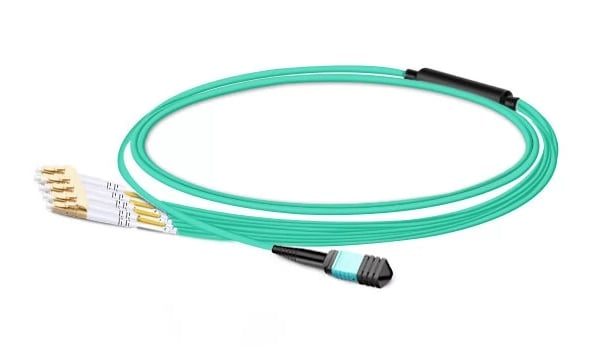
Improved Alignment and Reduced Insertion Loss
MTP cables are designed to have better precision while aligning and lowering the insertion loss. MPO standard connectors can be compared with MTP connectors due to their elliptical ferrules and high-quality guide pins, which provide higher accuracy and alignment. This kind of detailed adjustment helps to decrease signal losses, thus giving an insertion loss range from 0.1dB up to 0.35 dB as opposed to MPO’s insertion losses that begin at 0.3 dB, going all the way up to 0.75 dB. The decreased quantity of inserted power is essential for sustaining the great integrity of signals, especially over long distances or even in environments where there are many other densely packed together signals, so that systems may become more dependable when transmitting information efficiently over networks.
Advantages of MTP® Connectors in High-Density Networks
The design and performance of the MTP® connectors make them very useful in high-density network environments. These connectors have several advantages. First, they allow for higher fiber counts within one connector, which is necessary for space-limited data centers and network installations. This feature makes it easier to manage cables; it also helps to reduce congestion and improve airflow, thereby enhancing cooling efficiency.
Secondly, MTP® connectors are designed to speed up network deployment while making it more efficient. The push-pull design enables fast and reliable connection establishment, reducing installation time and labor costs involved in setting up networks, especially when scaling rapidly or upgrading infrastructure with minimal disruption.
Lastly, these types of connectors demonstrate excellent performance characteristics like lower insertion loss and higher return loss, which are essential for maintaining signal integrity over long distances or even in high-data-throughput environments. Such performance attributes guarantee strong and fast data transmission, thus making them suitable for use in modern-day high-density network architectures where large amounts of information need to be moved quickly through various points within such systems.
MTP® Fiber Cable Benefits in Fiber Optic Cable Systems
MTP® fiber cables have many advantages in fiber optic cable systems, which can help improve performance as well as efficiency. First, they allow for high-density connectivity that fits up to 72 fibers in a small form factor – this is especially useful for space-limited areas like data centers. Two, MTP® cables are made with a low insertion loss design to guarantee better signal integrity, which is necessary when transmitting large amounts of data at high speeds over long distances. Also, their strong build includes detachable housing, among other things, for easy reconfiguration and maintenance purposes. Such modularization enables flexible network planning while supporting scalability, which allows for effortless future upgrades or expansions. Last but not least MTP® fiber cables work well together with different types of MPO connectors and transceivers, hence providing convenient versatility that meets various networking needs without compromising on quality standards of performance and reliability.
Can MPO and MTP® Connectors be Used Interchangeably?
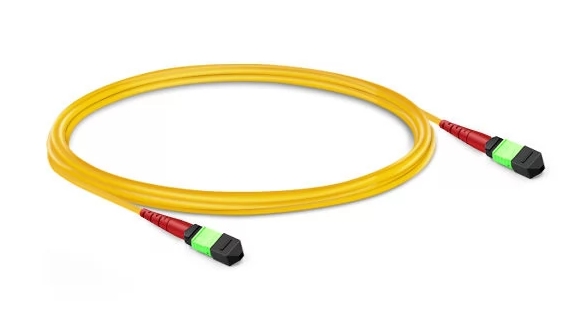
Compatibility Between MPO and MTP® Connectors
Their design and function are reminiscent of one another; hence, MPO (Multi-Fiber Push-On) and MTP® connectors can be replaced for each other most of the time. Although MPO is a generic connector type, US Conec designed the MTP® (MPO termination push), which is an improved version of this connector type that offers high-performance features. These two connectors follow the same international standards, which are IEC-61754-7 and TIA-604-5 (FOCIS 5), thus making them compatible with one another. On the other hand, MTP® connectors have better precision levels than those found in any other standard types, as well as tighter tolerance specifications, more advanced mechanical properties, and improved optical characteristics, which make them best for use in high-density or high-bandwidth applications. Therefore, even if they can work anywhere along fiber optic systems, whether to use an MPO or an MTP® connector should depend on what the network specifically requires.
Guide Pin Differences and Alignment
To keep the best signal quality, MPO and MTP® connectors need guide pins to correctly align the optical fibers within them. Both male (with pins) and female (without pins) versions can be found on the market for both MPO and MTP® connectors. The purpose of these pins is to carefully match up mirrored pairs of fibers during mating.
The guide pin structure in MTP® connectors has much tighter tolerances than those used in MPOs, resulting in better alignment and lower insertion loss when connecting two fiber optic cables together. What sets apart an average-quality connector from one that performs exceptionally well? In addition to having advanced features like pin clamps, which keep contacts stable while preventing breakage when linking up different parts of a network or system, this also ensures more accurate positioning, especially needed for high-density applications.
What do we know about them? They may look similar at first glance, but upon closer inspection, you’ll notice some differences between these two types, such as their sizes. They aren’t always interchangeable, though often mistakenly assumed as being so due largely because most people don’t understand what distinguishes each type from another, thus leading them to make wrong decisions based solely on appearance without considering functionality behind it, hence failing to achieve desired results simply because lack knowledge concerning this matter therefore if you want everything work perfectly then take note that every detail counts including even seemingly insignificant ones like size do matter, after all, it’s not just about looks alone but rather how things fit together too.
Therefore, while either can be used with both types of connectors, there are key differences between MPO and MT-RJ connector guide pins that should not be ignored if you want your system to work properly.
What are the Common Applications of MPO and MTP® Connectors?
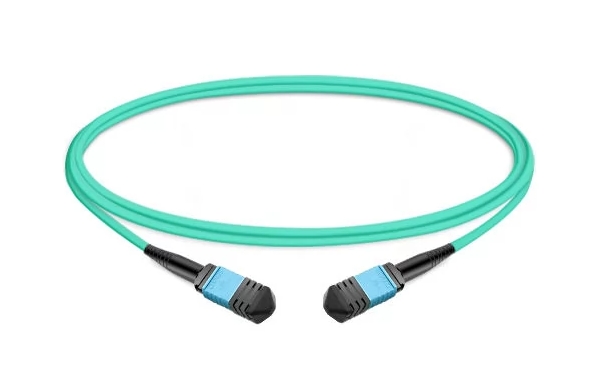
MPO Connector in Fiber Optic Networks
MPO connectors are popular in different fiber optic network applications because they can interconnect many fibers densely and help manage cables efficiently. These connectors are used in data centers, enterprise networks, and telecommunications systems, among other areas. They ensure fast and reliable connection of multiple fibers, thereby facilitating high-speed data transmission while simplifying network upgrades or scaling. The flexibility of MPO connectors allows them to be deployed on backbone cabling, trunk cables, and patch panels, which provide effective means of connecting and managing large numbers of fiber links. In essence, without these components, it would be difficult, if not impossible, for the current generation of fiber optic networks to exist in their present form – with such quick turnarounds possible!”
MTP® Connector in Data Centers
Data centers benefit greatly from MTP® connectors because they were created for high-performance, high-density fiber optic networks. These connectors are very precise and efficient, which helps speed up and improve network installations overall. Also, it allows rapid deployment as well as efficient scaling of infrastructure for networks so that bandwidth demand can be met with ease while still realizing data centers’ requirements for higher transmission speeds. They offer low insertion loss with high return loss, thus ensuring that critical applications run optimally; this is achieved through their ability to integrate seamlessly into current hardware configurations, thereby simplifying the management of vast fiber networks, leading to reduced downtimes coupled with fewer maintenance efforts required. In summary – without these things happening, everything else falls apart around it… so take the advice given!
Connecting MPO and MTP® Infrastructure Directly with Other MPO-Based Systems
An uninterrupted and effective network configuration is guaranteed if one MPO and MTP® infrastructure connects with another system based on the same technology. It should be noted that this link can be made possible by using converter modules or MPO/MTP® adapters, which accurately align fiber ends to attain minimal insertion loss as well as high return loss rates. These devices are convenient because they are designed for plug-and-play environments, hence allowing fast scalable installations that are necessary in data centers used by telecommunication service providers, among other organizations too. In addition, backward compatibility of the connectors with older systems ensures smooth execution of modifications without interrupting the current operations within a given network setup where an additional feature is achieved by these organizations through precision-aligned connectors together with high-performance adapters, i.e., companies can have better scalability for their networks while still ensuring maximum performance levels.
Reference sources
- US Conec
- Resource: “MTP® vs MPO Connectors: A Detailed Comparison”
- Source: US Conec
- Description: For those striving for technical knowledge, US Conec has presented a side-by-side comparison of MPO and MTP® fiber optic cable connectors with detailed explanations.
- AFL Hyperscale
- White Paper: “Unveiling the Distinctions: MTP® vs MPO Connectors”
- Description: In this white paper from AFL Hyperscale, the author covers the dissimilarities between MPO and MTP® connectors while also pointing out their specific features and uses in fiber optics.
- OFS
- Guide: “Navigating MTP® and MPO Connector Variations”
- Source: OFS
- Description: When it comes to differentiating between various types of MPOs or MTPs, OFS provides an excellent guide that will help you choose which one is best suited for your needs in terms of network requirements.
Frequently Asked Questions (FAQs)
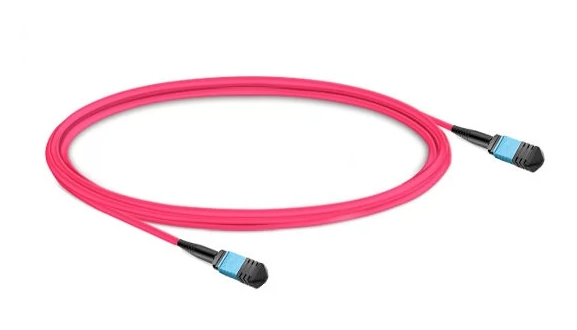
Q: What distinguishes MTP® connectors from MPO connectors?
A: The key distinction between MTP® and MPO connectors is based on quality and performance. These are enhanced types of MPO connectors that perform better, with a metal pin and a floating ferrule for improved physical contact.
Q: How different is an MTP connector from a standard MPO connector?
A: For one, there’s the use of floating ferrule and metal pin in an mtp connector, which makes it perform better than its counterpart with no such features, referred to as the standard MPO connector. This configuration ensures proper alignment of optical fibers while reducing insertion loss.
Q: Can you swap between MTP and MPO Connectors?
A: Yes, these two types of connectors can directly interconnect with each other or other systems based on Multi-fiber Push-on (MPO) connections. Nevertheless, it is important to note that using cables with improved design, like those containing multi-mode fiber, might offer higher performance levels throughout the network.
Q: What advantages does an MTP® connector have in a fiber optic network?
A: Lower insertion loss, increased reliability because of better physical contact, and the ability to manage 12-fiber or even 72-fiber connections, thus making them suitable for high-density applications, are some of the benefits associated with this type of connector, called mtp.
Q: What does 12 fiber mean about an MTP Connector?
A: A 12 fiber mtp connector is a cable or conductor designed to accommodate twelve strands of light within one housing unit. Such an arrangement is commonly used when dealing with large data transfer rates over short distances in densely populated areas where space-saving measures have been implemented.
Q: Why is MTP connector floating ferrule essential?
A: A floating ferrule is essential in an MTP connector because it will enable the fibers to stay aligned accurately with each other, ensuring good physical contact between them and reducing signal loss that may occur. This makes MTP more efficient than standard MPO connectors.
Q: Can one use multimode or single-mode fiber cables with MPO/MTP connectors?
A: Yes, you can use both multimode and single mode fibers on either MPO or MTP connectors. However, to achieve maximum performance, ensure that the right connector designed for a particular fiber optic mode is used.
Q: What are some typical applications for these types of connectors?
A: We typically find many uses for these types of connections in data centers, enterprise networks, and high-density fiber optic interconnects. These connectors are preferred in places where large amounts of information need to be transmitted through many channels at once using just one plug space.
Q: How does this affect network performance?
A: These connectors significantly boost overall network performance by saving space and improving connection quality. In addition, MTP provides better results due to reduced insertion loss brought about by its improved design, which leads to lower failure rates and makes it more reliable than any other type of connection.
Q: What should I consider when choosing between them?
A: When choosing between MPOs and MTPTMs, there are several things you need to think about, which mainly depend on what your specific needs may be at any given time; these considerations include but are not limited to network performance requirements, insertion losses as and density levels required within different parts one’s system setup, etc. Typically, however, people tend to go with MTP because they work better in high-stakes environments such as data centers where reliability matters most.
Related Products:
-
 1m (3ft) 12 Fibers Female to Female MPO Trunk Cable Polarity B LSZH OM3 50/125 Multimode Fiber
$20.00
1m (3ft) 12 Fibers Female to Female MPO Trunk Cable Polarity B LSZH OM3 50/125 Multimode Fiber
$20.00
-
 1m (3ft) 12 Fibers Female to Female MPO Trunk Cable Polarity B LSZH Multimode OM4 50/125
$21.00
1m (3ft) 12 Fibers Female to Female MPO Trunk Cable Polarity B LSZH Multimode OM4 50/125
$21.00
-
 1m (3ft) 12 Fibers Female to Female MPO Trunk Cable Polarity B LSZH OS2 9/125 Single Mode
$26.00
1m (3ft) 12 Fibers Female to Female MPO Trunk Cable Polarity B LSZH OS2 9/125 Single Mode
$26.00
-
 5m (16ft) 16 Fibers Female to Female MPO Trunk Cable Polarity B LSZH OM4 50/125 Multimode Fiber APC
$89.00
5m (16ft) 16 Fibers Female to Female MPO Trunk Cable Polarity B LSZH OM4 50/125 Multimode Fiber APC
$89.00
-
 35m (115ft) 12 Fibers Low Insertion Loss Female to Female MPO Trunk Cable Polarity B APC to APC LSZH Multimode OM4 50/125
$118.00
35m (115ft) 12 Fibers Low Insertion Loss Female to Female MPO Trunk Cable Polarity B APC to APC LSZH Multimode OM4 50/125
$118.00
-
 1m (3ft) 12 Fibers Female to Female Elite MTP Trunk Cable Polarity B Plenum (OFNP) OM3 50/125 Multimode Fiber
$36.00
1m (3ft) 12 Fibers Female to Female Elite MTP Trunk Cable Polarity B Plenum (OFNP) OM3 50/125 Multimode Fiber
$36.00
-
 1m (3ft) 12 Fibers Female to Female Elite MTP Trunk Cable Polarity B LSZH Multimode OM4 50/125
$36.00
1m (3ft) 12 Fibers Female to Female Elite MTP Trunk Cable Polarity B LSZH Multimode OM4 50/125
$36.00
-
 1m (3ft) 12 Fibers Female to Female Elite MTP Trunk Cable Polarity B LSZH OS2 9/125 Single Mode
$42.00
1m (3ft) 12 Fibers Female to Female Elite MTP Trunk Cable Polarity B LSZH OS2 9/125 Single Mode
$42.00
-
 1m (3ft) 24 Fibers Female to Female Elite MTP Trunk Cable Polarity A Plenum (OFNP) Multimode OM4 50/125 for 100GBASE-SR10 Connectivity
$63.00
1m (3ft) 24 Fibers Female to Female Elite MTP Trunk Cable Polarity A Plenum (OFNP) Multimode OM4 50/125 for 100GBASE-SR10 Connectivity
$63.00
-
 1m (3ft) 24 Fibers Female to Female Elite MTP Trunk Cable Polarity A Plenum (OFNP) OS2 9/125 Single Mode for 100G CPAK LR Connectivity
$105.00
1m (3ft) 24 Fibers Female to Female Elite MTP Trunk Cable Polarity A Plenum (OFNP) OS2 9/125 Single Mode for 100G CPAK LR Connectivity
$105.00
-
 1m (3ft) MPO UPC Female to 4 LC UPC Duplex OM3 50/125 Multimode Fiber Breakout Cable, 8 Fibers, Type B, LSZH, Aqua
$20.00
1m (3ft) MPO UPC Female to 4 LC UPC Duplex OM3 50/125 Multimode Fiber Breakout Cable, 8 Fibers, Type B, LSZH, Aqua
$20.00
-
 1m (3ft) MPO UPC Female to 4 LC UPC Duplex OM4 50/125 Multimode Fiber Breakout Cable, 8 Fibers Type B, LSZH, Aqua/Violet
$23.00
1m (3ft) MPO UPC Female to 4 LC UPC Duplex OM4 50/125 Multimode Fiber Breakout Cable, 8 Fibers Type B, LSZH, Aqua/Violet
$23.00

